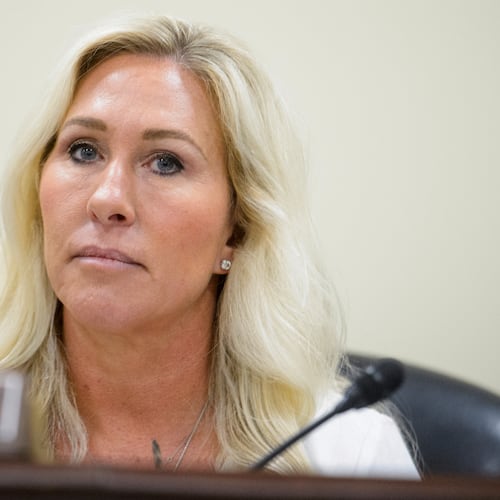As Gov. Brian Kemp moves to re-open the economy, researchers and ordinary Georgians are turning to the state Department of Public Health's published data on coronavirus cases, hospitalizations and deaths to draw their own conclusions on if it's safe to return to barber shops and restaurants.
They’d be easily confused.
Wednesday’s DPH count shows that new confirmed cases of the novel coronavirus jumped by more than 900 in a single day. Another count it released at the same time used a different method and showed they only rose by 31.
That same day, the agency’s case count suggested that Georgia may be experiencing the beginning of a plateau in COVID-19 cases. But a plummeting line in a DPH chart using the different method made it appear that new cases may have dropped.
» COMPLETE COVERAGE: Coronavirus in Georgia
» BEHIND THE DATA: Breaking down the statistical models of COVID-19
To add to the confusion, Kemp announced March 2 that there were only two coronavirus cases in Georgia. By the new counting method, 167 people actually had the disease. And the first known cases weren’t that date, but Feb. 1.
Throughout the pandemic the Kemp administration has repeatedly said data about the novel coronavirus is guiding decisions about what to close, how long to shelter and when to ease restrictions and reopen the state.
Tracking new cases, tests, deaths and other health measures are the cornerstone of a disease response, and DPH is publishing more data and additional metrics as the pandemic rolls on. Kemp himself cites projections from the University of Washington’s Institute for Health Metrics and Evaluation (IHME) during press conferences.
But IHME’s Ali Mokdad, a former Centers for Disease Control official who helped advise China and South Korea on how to build their own CDCs, told the AJC Georgia couldn’t possibly being relying on its data for such a decision.
“They’re not using our data to open,” Mokdad said. “They’re relaxing measures earlier than we say it’s safe.”
As of midday Thursday, IHME projected that it may be safe to begin easing restrictions after June 22, as long as the state puts into place strategies to contain the disease such as testing, contract tracing, and isolation.
A skeptical public remains confused about what information the governor’s office is using to decide it’s safe to venture from home.
“To me, it couldn’t be easier or less controversial for the reopening team to show their work and say, ‘Here’s what we’re looking at, and here are the data.’ These aren’t the nuclear codes,” said David Harrison, 43, of Dunwoody, an information technology worker who has joined with friends to build their own analysis of state data.
“I want people to be safe. I want the economy to open up, and I want it to open up in a balanced way, but who knows?” Harrison said.
Like climbing Mt. Everest
Experts agree that the number of cases in Georgia is still rising, and it has yet to meet the criteria the White House set forth in its guidelines for states that are considering re-opening. One was that the state post a 14-day decline in the percent of tests that are positive.
“We’re not yet seeing a decline in the number of cases in Georgia,” stressed Dr. Carlos del Rio, distinguished professor of medicine, epidemiology and global health at Emory University. The rate of the novel coronavirus’ progression through Georgia appears to be slowing, but even if the peak has already passed, the danger is far from over.
“It’s no different than saying, ‘Oh I’m going to go up Mount Everest. I got to the peak and I’m done’,” del Rio said. “No you still have to come down from the peak, and coming down can be just as dangerous as going up.”
» RELATED: Faulty data obscures virus' impact on Georgia
» MORE: Georgia's evolving testing machinery will be tested as state reopens
DPH data needs to be handled with care, experts agreed. While the state has made great strides beefing up its testing infrastructure, it still lags so far behind the rest of the nation the state simply doesn't have enough to answer basic questions about the spread of the virus, said Dr. Harry J. Heiman of Georgia State University's School of Public Health.
“Do we have adequate data today, or did we have it two days ago, or will we two days from now to convincingly know that we’re on a sustained downward trajectory?” Heiman said. “I think the answer is unequivocally, ‘No.”
And the data collection itself still has flaws.
» RELATED: Kemp reopens some businesses, despite warnings that COVID-19 still a threat
» THE LATEST: Tracking reported deaths and cases from DPH data
Earlier this month, an AJC investigation found that the state was using out-of-date, incomplete and sometimes inaccurate numbers. DPH could not identify the race of more than half of the Georgians who have tested positive for the virus, a key data point for understanding the effects on minority communities. State officials have since acknowledged they need to improve.
Understanding the fine print
Users must pay close attention to the fine print as Georgia posts new metrics to describe the spread of COVID-19. Charts and graphs introduced this week on DHS’ reporting website may appear to the casual reader as showing a dramatic decline in new cases. But they use a different counting method that pushes back the date a case is tallied as “new” by days or weeks before what was originally reported.
In these recently introduced visualizations, the “new” date is changed — whenever information is available — to the day the symptoms began or the sample was taken, whichever is earlier.
"They're not using our data to open. They're relaxing measures earlier than we say it's safe." —Ali Mokdad, a former CDC official who works at the University of Washington's Institute for Health Metrics and Evaluation
The cumulative counts DPH has released every day since March show the date of a new case as the day the agency received the results of the test.
Georgians following the death toll noticed the new metrics immediately and wondered why cases appeared to be rising and dropping at the same time. DPH’s report gave scant explanation.
“People are confused and scared, and one thing that can assure people is having data they can rely on that’s consistent,” said Jaime Graham, 42, an Atlanta resident who studied the data with her husband to see if it will be safe to send their two children to summer camp.
“But if we can’t trust, or our data is incomplete, it’s going to really hold us back,” said Graham, who previously worked in a Republican congressional office.
Dating a case to the onset of symptoms is generally the best method for tracking the spread of a disease, said Professor Benjamin Lopman, an infectious disease specialist at the Rollins School of Public Health at Emory University.
But days or weeks can pass between when a person shows signs of a disease to when his or her test is reported to the state. New counts will remain artificially low for days, if not longer, until they are updated.
“It’s important that we keep an eye on what’s happening, but you need to look at the slightly longer trends happening on any given day,” said Lopman. “The number of cases today or tomorrow shouldn’t affect an individual’s choices in their behavior.”
Lopman’s observation is born out by a major upward revision the state made after it released Wednesday’s figures. Originally, it reported that only 31 new cases took place that day. Within 24 hours, the new cases jumped to 72, an increase of 132%.
However the state reports its data, researchers are convinced they will be able to sort out the true scope and impact of the disease over time.
“Whatever you try to do with data right now, you can’t hide it,” said Mokdad. “Truth will not be hidden.”
Staff Writers Emily Merwin DiRico, Jennifer Peebles, Isaac Sabetai, J. Scott Trubey and Nick Thieme contributed to this report.
About the Author
Keep Reading
The Latest
Featured





